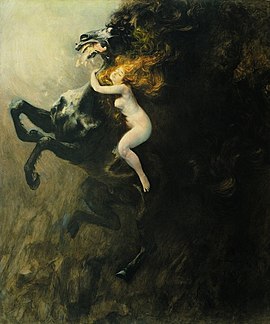Frenzy of Exultations
| Szał (Frenzy) | |
|---|---|
 | |
| Artist | Władysław Podkowiński |
| Year | 1893 |
| Type | Oil on canvas |
| Location | National Museum in Kraków, Cracow |
Frenzy of Exultations or better known as just Frenzy is the most famous work in Podkowiński's output. The painting is considered the first work of symbolism in Polish art[1], which lasts when Poland was torn off by neighbours: Russia, Germany and Austria.
Description
The painting shows a naked, redheaded woman on the black crazy horse. The horse reveals its teeth with its tongue shown. Its nostrils are expanded and foam running from his mouth. The woman riding on horse's bareback covers its neck with her eyes closed, her hairs are mixed with horse's mane. The canvas is over 3 meters in height, which means that the figures are of natural size.
The color range is quite narrow and is composed of blacks, browns and grays contrasting with the white and yellow. The image is divided into light and dark parts (see also: chiaroscuro). Upper left corner is illuminated, directing attention to a clear figure of a woman and the horse's mouth. The right side of painting shows whirled darkness in which you can see the horse's hind and tail.
Background
The concept of this work dates back to Podkowiński's stay in Paris in 1889, but the emergence of successive oil sketches and charcoal studies in the second half of 1893 was the consequence of the growing drama of unrequited love in the artist's life. In his vision, Podkowiński elevates erotic ecstasy to an absolute value, regarding it, in accordance with the psychologism current for that time, as the cosmic power and determinant of the human condition. Setting about the execution of the huge painting, he employed the academic method of preparatory sketches that correspond to the final version while differing slightly one from another in size and colour. Reduced in colour scheme, they range from the ultramarine version (lost), through work enlivened with green, to the subsequent ones, in which intense orange predominates. The stones avalanche was removed from final version as well. In comparison with the sketches, the final, monumental composition gained in dynamism and the previously weak contrast of colour intensified to that between golden and black, and the tension between light and shadow was more polarised. This could be an effect of his private life drama and the progress of his lung disease.
History
Podkowiński started to paint in Warsaw between 1893 and 1894. The creation process lasted at least three months and according to a friend: at the end he was painting from his bed. The painting was shown at the Zachęta exhibition on 18 March 1894. The exhibition was accompanied by an atmosphere of sensationalism and scandal but around 12,000 people saw the picture, making nearly 350 rubles for the gallery.
Despite the success of the painting, it couldn't find a buyer: 3000 rubles was offered but the artist asked for 10,000.
On the morning of 24 April 1894 (37 days since the exhibition opening), just before the planned end, the painting was cut with a knife by its creator. The reasons for this act are unclear.
The artist's decision may have contributed to the rumors that the image portrayed a woman towards which the artist had an unfulfilled affection. The destruction of the image, and Podkowinski's death fueled the speculation, adding to the legend of a suicide. Providing a rationale for this explanation are the traces of cuts on the canvas showing that only the image of the woman was under attack. The object of the artist's feelings could be Ewa Kotarbińska, whom he met during his summer stay in a palace near Warsaw. She was a brunette, but some[citation needed] record that her family saw a similarity between her and the woman in the painting and harshly condemned him. The artist destroyed the painting.
After Podkowinski`s death the painting was restored by Witold Urbański. The restored work was lent to other exhibitions in Łódź, Kraków, Moscow and Saint Petersburg. Finally, the canvas was purchased by Feliks Jasieński in 1901 for 1,000 rubles, and in 1904 was given to the National Museum in Kraków.
References
